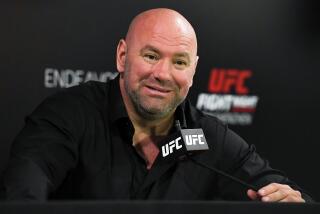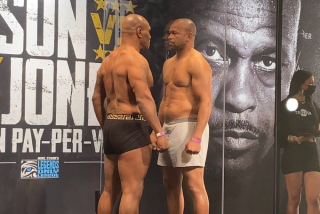UFC tries to stem criticism over its drug-testing protocol ahead of Jon Jones’ return to the octagon

- Share via
A UFC executive and noted anti-doping figure Friday sought to quell mounting criticism of the organization’s decision to allow former light-heavyweight champion Jon Jones to fight in Saturday’s UFC 232 main event at the Forum despite the presence of a steroid metabolite in his system earlier this month.
“Optically, not a pretty picture, but I stand up here 100% confident in [the U.S. Anti-Doping Agency] decision-making and these experts that they have, and I believe this is the right thing to do, this fight going on tomorrow,” Jeff Novitzky, the UFC’s vice president of athlete health and performance, told reporters.
Saturday’s light-heavyweight title rematch between Jones and Alexander Gustafsson was moved to the Forum after Nevada last week ruled it wouldn’t immediately sanction the bout for T-Mobile Arena in Las Vegas.
After making weight Friday in Los Angeles, Jones (22-1) will earn a guaranteed $500,000 for the bout.
Novitzky disputed the contention by steroid experts that the decision to allow Jones to fight following a positive test is unprecedented.
“There’s another sports league out there that’s had this issue pop up multiple times, and they’ve handled their adjudication the same way that USADA handled Jones,” Novitzky said, declining to identify the league because of collective-bargaining agreements. “As long as the science showed residual effect in subsequent tests, they were not punished again. It’s really a matter of double jeopardy.”
The Nevada Athletic Commission informed the UFC that the state needed to gather experts to assess the Dec. 9 test that found 60-to-80 picograms, considered a small amount, of the banned steroid turinabol in Jones.
The California State Athletic Commission had Jones take a steroid test that he passed Saturday in San Dimas, and leaned on expert opinions from World Anti-Doping Agency lab director Dr. Daniel Eichner and retired USADA chief science officer Larry Bowers to allow the fight.
Those experts concluded that the trace metabolite level would have no performance-enhancing effect for Saturday’s fight, and Eichner wrote that the metabolite likely resulted from its long-lasting effect and dated to Jones’ positive test for the drug last year in Anaheim.
In July 2017, after Jones stopped Daniel Cormier by technical knockout at Honda Center, he was found to have the same metabolite in his system, leading the California State Athletic Commission to suspend him until October of this year, fine him more than $200,000 and change his victory to a no-contest.
Jones said the substance entered his body through a contaminated supplement, and an independent arbitrator, citing Jones’ unspecified “assistance” with investigators, ultimately spared him of a potential four-year ban following his 2016 positive for another banned substance before UFC 200 in Las Vegas.
In a nod to the contractual ties between UFC and USADA, Andy Foster, executive officer of the California commission, summoned the Las Vegas-based Voluntary Anti-Doping Assn. to handle the remainder of pre-fight tests on Jones.
VADA will be allowed to test Jones up to 10 times for the next six months.
Oliver Catlin, president of the Los Angeles-based Anti-Doping Sciences Institute and Banned Substances Control Group, said there are no published administration studies that prove the turinabol metabolite can last the 17 months that Jones’ supposedly has.
“Correct,” Novitzky admitted of the absence of studies, “but you have to look at the compound…. The parent compound is what makes you quicker, stronger, faster. There’s no evidence out there that this metabolite has effects on the body. It’s just a sign of past ingestion.”
Novitzky said the UFC will back a possible future WADA mandate ordering drug labs to decrease the threshold of the banned substances they’re measuring for, to help avoid the cloud of controversy that hangs over the Jones-Gustafsson fight.
“From when I first started 17 years ago …, the pendulum has swung too far now and the level of sensitivity [in screening] now is so great,” Novitzky said. “You have to be really careful and subjective in looking at each case.”
Jones has “already been punished [from the 2017 positive] … it’s been determined it was non-intentional and he’s lost income of tens of millions of dollars,” Novitzky said.
And now Jones returns … .
Twitter: @latimespugmire
More to Read
Go beyond the scoreboard
Get the latest on L.A.'s teams in the daily Sports Report newsletter.
You may occasionally receive promotional content from the Los Angeles Times.











